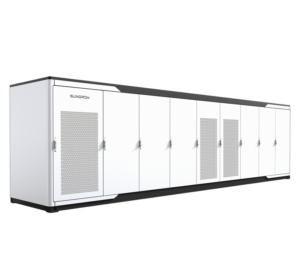Sungrow‘s PowerTitan solar battery system is engineered not only to store and manage solar energy efficiently but also to integrate seamlessly with modern power grids. This blog will explore the PowerTitan’s grid connection characteristics and how these features ensure compatibility, stability, and efficiency in a range of grid environments.

Total Harmonic Distortion (THD) of Current
The PowerTitan exhibits impressive performance in terms of Total Harmonic Distortion (THD) of current, with specifications that ensure minimal interference and maximum efficiency in power delivery:
– At Nominal Power: The THD of current remains below 3%, indicating a high level of purity in the AC output. This low THD level is crucial for preventing power quality issues in the grid, which can lead to inefficiencies and potential damage to both the grid infrastructure and connected devices.
– Optimal Conditions: Under ideal operating conditions, the THD can be as low as 0.5%, which is significantly better than many competitors. This indicates an exceptionally smooth and efficient delivery of power, enhancing overall system performance and longevity.
Power Factor Range
The PowerTitan’s power factor range is expansive:
– Range: From 1.0 leading to 1.0 lagging. This wide range allows the system to not only supply active power but also manage reactive power effectively. Managing reactive power is essential for maintaining voltage stability on the grid and reducing losses in power transmission.
Efficiency at Nominal Power
A critical measure of a battery system’s grid compatibility is its efficiency at nominal power:
– Efficiency: The system maintains a power factor of greater than 0.99 at nominal power. This near-unity power factor means that almost all the power generated by the system is usefully employed, with very little being wasted as reactive power. This efficiency is crucial for both reducing energy costs and enhancing the environmental benefits of solar power systems.
Grid Frequency Compatibility
The PowerTitan is designed to operate within a broad frequency range, making it adaptable to different grid standards around the world:
– Nominal Grid Frequency: The system is compatible with both 50 Hz and 60 Hz, accommodating the standard grid frequencies used globally.
– Grid Frequency Range: It operates within a frequency range of 45 to 55 Hz for 50 Hz grids and 55 to 65 Hz for 60 Hz grids. This flexibility ensures reliable operation even when grid frequencies deviate from their nominal values, which can occur during grid instabilities or anomalies.
Conclusion
Sungrow’s PowerTitan is designed not just as a solar battery storage solution but as a robust component of the modern smart grid. Its advanced specifications in THD, power factor, and grid frequency compatibility ensure that it can integrate smoothly into various grid systems, support grid stability, and enhance overall energy efficiency. For utilities, commercial enterprises, and industrial operators looking to invest in a top-tier solar battery system, the PowerTitan offers the reliability, efficiency, and grid support needed to maximize the benefits of solar energy. This system exemplifies how advanced engineering can meet the dual challenges of energy sustainability and grid stability.





